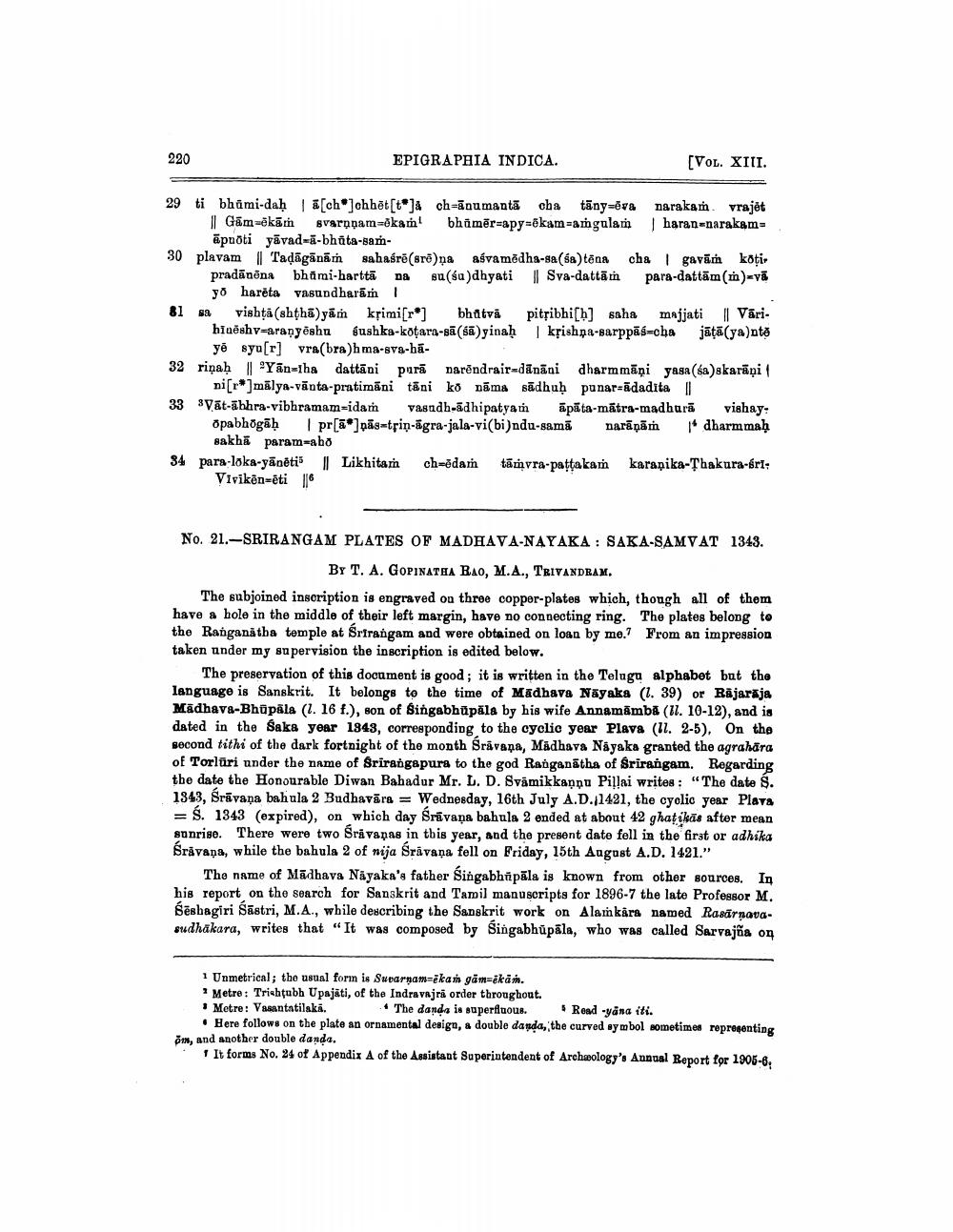________________
220
EPIGRAPHIA INDICA.
[VOL. XIII.
29 ti bhumi-dah | [ch] chhot[t]A ch=ānu mantācba täny-ova narakam vrajét
|| Gāmokām svarnnam=okam! bhūmēr=apy=ēkam-amgulan haran-narakam
āpuoti yāvad-a-bhäta-sam30 plavam || Tadāgānār sahasrē (aro)na aśvamodha-safa)tona cha gavā koti.
pradūnona bhūmi-harttā da (sa)dhyati | Sva-dattām para-dattām(i)=vā
yo harēta vasundharām 81 sa vishţa(shtha)yām krimi[r] bhätvä pitsibhi[h] saha majjati | Vāri
bīneshy-aranyoshu fushka-kotara-sā (sā)yinaḥ kṣishna-Barppas-cha jātā(ya)nto
ye syo[r] vra(bra)hma-sva-ha32 riņaḥ | 'Yan-1ha dattāni parā varēndrair=dānāni dharmmāni yasa (sa)akarāņi
ni[ro]mālya-vānta-pratimāni tāni ko nāma sādhuḥ punar-ādadita | 33 SVāt-abhra-vibhramam-ida vasndh-adhipatyam apāta-matra-madhurā vishay:
Opabhögāḥ pr[a]pās=tsin-agra-jala-vi(bi)ndu-samā narāṇām * dharmmaḥ
sakhā param=abo 34 para-loka-yānēti Likhitar ch=ēdam tām vra-pattakam karapika-Thakura-bri,
Viviken=ēti 16
No. 21.-SRIRANGAM PLATES OF MADHAVA-NAYAKA : SAKA-SAMVAT 1343.
BY T. A. GOPINATAA BAO, M.A., TRIVANDRAM. The subjoined inscription is engraved on three copper-plates which, though all of them have a hole in the middle of their left margin, have no connecting ring. The plates belong to the Ranganatha temple at Srirangam and were obtained on loan by mo.? From an impression taken under my supervision the inscription is edited below.
The preservation of this document is good; it is written in the Telugu alphabet but the language is Sanskrit. It belongs to the time of Madhava Nayaka (1. 39) or Rajaraja Madhava-Bhüpäla (1. 16 f.), son of Singabhūpāla by his wife Annamāmba (11. 10-12), and is dated in the Saka year 1843, corresponding to the cyclic year Plava (11. 2-5). On the second tithi of the dark fortnight of the month Śrávaņa, Madhava Nayaka granted the agrahāra of Torlari under the name of Srirangapura to the god Ranganatha of Srirangam. Regarding the date the Honourable Diwan Bahadur Mr. L. D. Svåmikkannu Pillai writes: "The date $. 1343, Srāvana bahula 2 Budhavārs = Wednesday, 16th July A.D. 1421, the cyclic year Playa =s. 1343 (expired), on which day Srāvana bahula 2 ended at about 42 ghatikās after mean sunrise. There were two Sråvapas in this year, and the present date fell in the first or adhika Srāvana, while the bahula 2 of nija Srāvana fell on Friday, 15th August A.D. 1421."
The name of Madhava Nayaka's father Singabhäpāla is known from other sources. In his report on the search for Sanskrit and Tamil manuscripts for 1896-7 the late Professor M. Śēshagiri Sastri, M.A., while describing the Sanskrit work on Alamkars named Rasārnavasudhakara, writes that “It was composed by Singabhūpāla, who was called Sarvajña on
1 Unmetrical; the usual forn is Suvarnam=ēkan gam=ékan.
Metro: Trishtubh Upajati, of the Indravajră order throughout. • Metre: Vasantatilska.
The danda is superfluous. Rond -yana iti. • Here follows on the plate an ornamental desiga, a double danda, the curved symbol sometimes representing ön, and another double danda.
. It forms No. 24 ot Appendix A of the Assistant Superintendent of Archwology's Annual Report for 1905-8.




